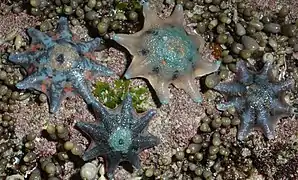Meridiastra calcar
Meridiastra calcar, formerly classified as Patiriella calcar and commonly known as carpet sea star, cushion sea star or eight-armed sea star, is a species of sea star found in Australia.
| Meridiastra calcar | |
|---|---|
 | |
| Scientific classification | |
| Domain: | Eukaryota |
| Kingdom: | Animalia |
| Phylum: | Echinodermata |
| Class: | Asteroidea |
| Order: | Valvatida |
| Family: | Asterinidae |
| Genus: | Meridiastra |
| Species: | M. calcar |
| Binomial name | |
| Meridiastra calcar (Lamarck, 1816) | |
| Synonyms | |
| |
Description
The cushion sea star has eight short, distinct, triangular "arms", though 7- or 9-armed individuals can be found. These "arms" are laterally fused together for some of their length, leaving ray-like tips of varying length to jut from the disk-like body. This species aboral surface can be any colour or combination of colours, while the oral side is uniformly pale. This sea star attains a maximum diameter from arm tip to arm tip of 5 cm-10 cm.
Distribution and habitat
The cushion sea star is found in the intertidal zone of Australian coasts from Western Australia's south coast to Queensland's coast off Currumbin, while including Tasmania, South Australia, Victoria and New South Wales. This sea star species favours rocky coasts abiding both in tide pools and to a maximum depth of 3 meters below sea level.
Ecology and behaviour
Like other sea stars, the cushion sea star is a slow-moving animal using its tube feet to move about, collecting or subduing the food items that constitute this omnivorous species diet, namely, algae, detritus, mussels and other invertebrates. This species is viviparous like a few others classified in the genus Patiriella, brooding its young within the body.
References
- Sea stars - Class Asteriodea[sic]. Retrieved 2008-01-29.
- Keith Davey. Life on Australian Seashores - Eight-armed Seastar Patiriella calcar.
- Australian Museum Online. Wildlife of Sydney - Fact File - Carpet Sea Star. Retrieved 2008-01-29.